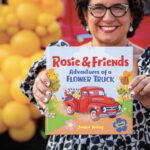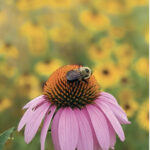
Build it, and they will come.
In the case of Hundredfold Farm, they stayed.
There are just four empty lots left—and the neighborhood extends the invitation to join to anyone willing and interested.
Twenty years ago, Bill and Sandy Hartzell and other likeminded people broke ground for a sustainable co-housing community, but it took six years to get the first house up. Today, 10 houses are tucked into the hillside, each one boasting picture windows, solar panels, rain barrels and sweeping views of the surrounding countryside.
“When we started this, the primary reason was that we were tired of being isolated,” says Bill Hartzell. “We wanted to demonstrate another way to house people without spreading them out in a huge housing development.”
The Hartzells moved from Seattle to just outside Gettysburg in the late 1990s and immediately began asking around for interested households to build a co-housing community, based on a Scandinavian living concept of shared spaces and collaborative management and decision-making.
Focused on cultivating multigenerational, interpersonal relationships, residents of Hundredfold Farm welcome neighborly interaction and rely on each other to collectively make decisions and find consensus.
The idea of cohousing was a vehicle for the community to preserve farmland and open spaces, but also an opportunity to live more consciously and sustainably.
Once the site of an organic Christmas tree farm, the clustered residences are surrounded by 80 acres the community co-owns and manages, equally sharing the benefits and the responsibilities of the land around them. The households share the land and facilities, its yard and farm work, and the tools and equipment to get it done.
The houses share a common drive, and all cars are parked in a community lot. A neighborhood garden grows food and flowers for all to share, and compost piles are tended to in turn. A barn stores shared goods and equipment, the common house offers shared facilities and gathering space, and an artificial marshland in a greenhouse remediates wastewater to grow flowers and flush toilets.
Though much is shared, privacy is not an issue, and serenity is not sacrificed. The houses at Hundredfold Farm are all different styles and colors and are further apart than houses in most subdivisions.
“We know each other well enough to know when to give space, to know what is going on in each other’s lives,” said Sandy Hartzell.
The benefits of a close-knit community go well beyond monthly community meetings and shared chores.
When Linda Miller had to move her mother into the community years ago, she never could have done it without the support from the Hundredfold family.
“It’s so different, knowing your neighbors,” Miller said. “You really learn to live and love with them. We’re a big family.”
Of course, you clash and bump heads, she said, but you learn to respect each other’s ways of seeing the world.
“It forces you to grow,” she said. “You can’t stay who you were.”
She has lived at Hundredfold for 15 years and decided recently to sell her home in order to build a smaller one two lots over—to downsize and make it affordable for another family to move in.
Tax breaks and country living make the community more attractive for homeowners. The cheaper, co-owned land initially drew Emily Windover and her family to Hundredfold. Her family of five needed more space and has lived there for three years. It’s been the other benefits of co-housing, though, that Emily and her family have enjoyed most.
“I love knowing our neighbors and that we’re all working toward a common purpose,” Windover said.
In their previous community, they didn’t know their neighbors, and it was difficult to resolve conflicts.
“There’s a commitment to community here, and I feel comfortable asking for help,” Windover said.
She thinks the co-housing concept has been great for her children to see examples of adults working together.
“They’re seeing us wrestle with these problems and ultimately come to consensus,” Windover said.
Bill Hartzell also believes the impact that co-housing has on children is unmatched in other models. He and Sandy raised their two sons in co-housing communities, and they believe it is this structure that gives kids a unique perspective on the world.
“They are very aware of what happens in groups and what can happen in groups,” he said. “Growing up, they experienced grownups actually working together, looking after each other, and solving problems—not just walking away from them.”
The co-housing dynamic is often a challenge for adults because most of life isn’t structured around finding consensus and collaboration.
“I don’t think anybody brings with them the skills needed to live and make decisions with other people,” he said. “You have to be willing to learn some new things about yourself and about working with other people.”
But for the kids who grow up in it, it comes more naturally, and Bill said that they are some of the most self-confident, creative and compassionate people he has ever met.
Bill believes the children are the most positive part of co-housing communities. That makes him feel better about the work they are doing and about the future in general.
“You’ve got to see some kind of progress in your lifetime,” he said.
The Hundredfold Farm Co-Housing Community is located at 1400 Evergreen Way, Orrtanna. For more information, call 717-321-0004 or visit www.hundedfoldfarm.org.





